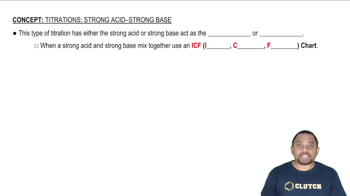A 30.0-mL sample of 0.165 M propanoic acid is titrated with 0.300 M KOH. Calculate the pH at each volume of added base: one-half equivalence point.
Ch.18 - Aqueous Ionic Equilibrium
Chapter 18, Problem 79a
Consider the titration of a 25.0-mL sample of 0.175 M CH3NH2 with 0.150 M HBr. Determine each quantity. a. the initial pH
 Verified step by step guidance
Verified step by step guidance1
insert step 1> Start by identifying the species present in the solution before any titrant is added. In this case, you have a solution of methylamine (CH_3NH_2), which is a weak base.
insert step 2> Write the equilibrium expression for the weak base dissociation: CH_3NH_2 + H_2O \rightleftharpoons CH_3NH_3^+ + OH^-.
insert step 3> Use the base dissociation constant (K_b) for methylamine to set up the equilibrium expression: K_b = \frac{[CH_3NH_3^+][OH^-]}{[CH_3NH_2]}.
insert step 4> Assume that the initial concentration of OH^- is negligible and that the change in concentration of CH_3NH_2 is small compared to its initial concentration. This allows you to simplify the expression to: K_b = \frac{x^2}{[CH_3NH_2]_{initial}}, where x is the concentration of OH^-.
insert step 5> Solve for x, which represents [OH^-], and then calculate the pOH of the solution. Finally, convert pOH to pH using the relation: pH = 14 - pOH.

Verified video answer for a similar problem:
This video solution was recommended by our tutors as helpful for the problem above.
Video duration:
3mWas this helpful?
Key Concepts
Here are the essential concepts you must grasp in order to answer the question correctly.
Acid-Base Titration
An acid-base titration is a quantitative analytical method used to determine the concentration of an acid or base in a solution. In this process, a solution of known concentration (the titrant) is added to a solution of unknown concentration until the reaction reaches its equivalence point, where the amount of acid equals the amount of base. Understanding this concept is crucial for calculating pH changes during the titration.
Recommended video:
Guided course

Acid-Base Titration
pH Calculation
pH is a measure of the acidity or basicity of a solution, defined as the negative logarithm of the hydrogen ion concentration. For weak bases like CH3NH2, the initial pH can be calculated using the base dissociation constant (Kb) and the concentration of the base. This calculation is essential for determining the starting conditions before any titrant is added.
Recommended video:
Guided course

pH Calculation Example
Weak Base and Strong Acid Interaction
In the titration of a weak base (like CH3NH2) with a strong acid (like HBr), the weak base will partially ionize in solution, establishing an equilibrium. The addition of the strong acid will shift this equilibrium, affecting the pH. Understanding the behavior of weak bases in the presence of strong acids is vital for predicting how the pH will change throughout the titration process.
Recommended video:
Guided course

Strong Acid-Strong Base Titration
Related Practice
Textbook Question
Textbook Question
A 30.0-mL sample of 0.165 M propanoic acid is titrated with 0.300 M KOH. Calculate the pH at each volume of added base: 20 mL.
Textbook Question
A 30.0-mL sample of 0.165 M propanoic acid is titrated with 0.300 M KOH. Calculate the pH at each volume of added base: 25 mL.
Textbook Question
Consider the titration of a 25.0-mL sample of 0.175 M CH3NH2 with 0.150 M HBr. Determine each quantity. c. the pH at 5.0 mL of added acid
1
views
Textbook Question
Consider the titration of a 25.0-mL sample of 0.175 M CH3NH2 with 0.150 M HBr. Determine each quantity. e. the pH at the equivalence point
Textbook Question
A 25.0-mL sample of 0.125 M pyridine is titrated with 0.100 M HCl. Calculate the pH at each volume of added acid: 0 mL.
